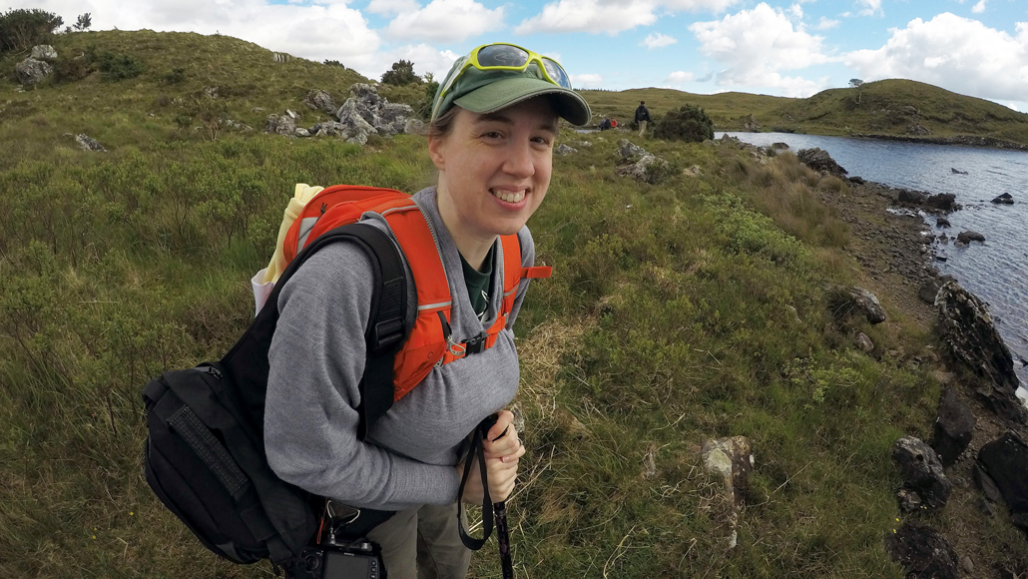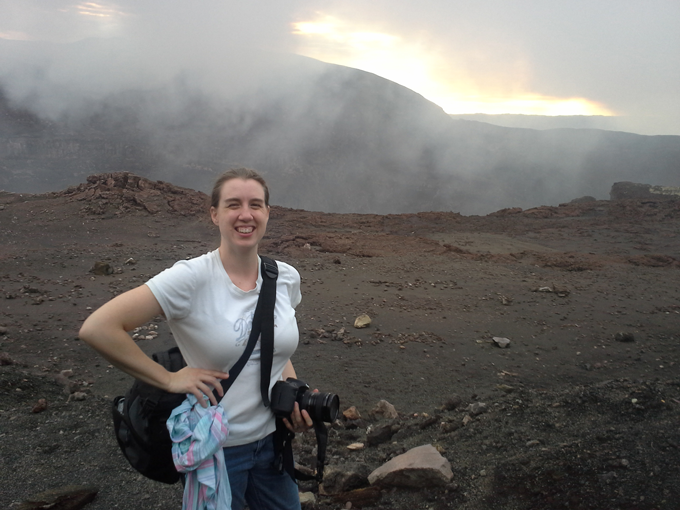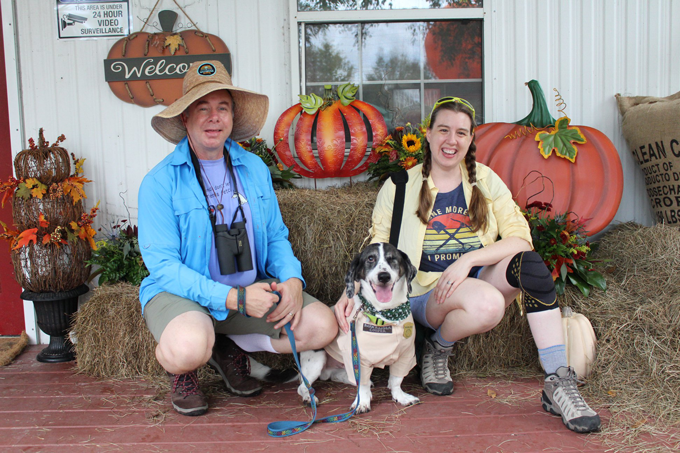An accident didn’t stop this geologist from doing field work
Now Anita Marshall works to help other scientists with disabilities pursue research careers

Field work became more of a challenge for geologist Anita Marshall after a car accident left her with a disability. Now she works to help others with disabilities learn about geology. In this picture, from a trip to Ireland with students, “I am leaning on my stick because I had really pushed myself too far that day physically but was having too much fun helping students and tromping through the bog,” she says.
Courtesy of A. Marshall
Updated
A career in geology often involves hiking boots or a hard hat. Sometimes both. A geologist often spends at least part of her time in “the field,” as opposed to in the lab. And that field work is one of the things Anita Marshall loves most about geology. She wanted to hike across mountains and climb rock walls — all while doing science. But that work suddenly got much harder when she was in graduate school. A drunk driver hit her while she was unloading her pickup truck.
Marshall needed six surgeries and used a wheelchair for about a year. Then she had to learn to walk again. She still has nerve damage and other effects. Yet she didn’t let that stop her from becoming a geologist. Now, at the University of Florida in Gainesville, she works on ways to help others with physical disabilities learn about geology.
Marshall, a member of the Choctaw Nation, has taken some dramatic turns along the way. She recently shared her experiences and advice with Science News for Students. (This interview has been edited for content and readability.)
What inspired you to pursue your career?
When I started college, I wanted to be a high school band instructor. Then I took an intro-to-geology class. I had loved a similar class in high school. One weekend, it came down to learning how to play the clarinet or hiking with the geology class. I chose to go hiking. And I’ve never looked back. I changed my major to Earth science. After that I worked on my master’s degree.
Then a drunk driver hit me.
Until then, all the work for my graduate-research project had been physically intensive. My graduate advisor asked if I wanted to do a computer-based project instead. But I wanted to finish.
I had been using GPS (global positioning system) equipment to track how the ground was sinking in part of eastern Arkansas. Farmers were rapidly pumping out groundwater there. My project was the first to measure that change on the ground surface. My advisor said, “OK, we’ll figure out how to make the rest of the project work.” And we did. I used a walker to help me get as far as I could in the field. My sister and my dad went the rest of the way. They helped get the data I needed to finish. And I graduated a year behind schedule.
Originally my passion was to be a field geologist. But I felt I couldn’t do that after my accident. Instead, I taught in a community college for seven years. I loved it. But I missed doing research and tackling tough science questions.
A video I used in class showed geologist Stanley Williams of the University of Arizona. He was badly hurt in a volcanic eruption. Some of his injuries were similar to mine. And he still got out into the field. Seeing that gave me the push I needed to go back to school.
How did you get where you are today?
I started out studying volcanoes for my PhD. But for someone with limited mobility, hiking a volcano is very difficult. I was going to put a chapter in my final research paper about making field work more accessible. The same week I put that in my outline, I learned about a research project along the same lines. The researchers were looking for college-level geology students with disabilities. I emailed them and asked if I could work on the research as a grad student. They said yes. This completely turned my whole career around.

That GEOPATH project field-tested ways to let college students with disabilities take part in field work. We took students to places like western Ireland in the United Kingdom, northern Arizona and Mammoth Cave National Park in Kentucky. That project has ended. And now I’m continuing to work in that area. I’m starting a lending library of technology tools to make field work more accessible. Students with disabilities will be able to borrow drones (robotic aircraft), iPads, GoPros and more.
How do you get your best ideas?
Instead of seeing each project as starting from scratch, I like to see them as building blocks. When you complete a big project, there’s always some need or some question that wasn’t answered. That is always the best place to start for your next project.
For example, the GEOPATH project only targeted people who are mobility limited. There are so many other types of disabilities. In future projects, I’m looking at how to throw the net even wider and help even more people learn about geology.
What’s one of your biggest successes?
Finishing my PhD. It was very difficult. A lot of it had to do with confronting social barriers — people who felt like I didn’t belong there. There were people who made it clear to me that I was not welcome, that if I couldn’t keep up physically, I was no kind of geologist.
One time I was out in the field and was tired. As I sat on a rock, students walked past. “I don’t even know why she bothers,” one of them said. That moment was sort of a game changer for me. After that trip, I thought, there’s got to be a better way of doing this. We can’t keep this up, this idea that if you’re not some hale-and-hearty Indiana Jones type, you can’t be a geologist. It just doesn’t make sense.
I felt really alone on that rock in the middle of nowhere while people were making fun of me for being there. It turned out I wasn’t alone. There is a huge unmet need for finding ways so that everybody who wants to be a geology student and who wants to study the Earth can do so.
What’s one of your biggest failures, and how did you get past that?
One time on the GEOPATH project, we set up little Wi-Fi hot spots out in the field. The idea was that everyone could talk to each other just like you would on a cell phone. So, students with limited mobility could stay in touch with everyone else. It colossally failed. It just didn’t work at all. And the students felt very left out.
We regrouped the next day and got the system to work really well. But I take those failures really hard, because they don’t just affect me. They affect the students, the ones who deserve to be part of what’s going on.
In research science, you have to learn to change your mentality and look at all these failures not as something you failed at, but just as part of the process of science.
What do you do in your spare time?
My first love is photography. There’s nothing more relaxing to me than a great photography session, either landscape photography or taking portraits.
I do a lot of crafts, too. Usually it has to do with figuring out ways to use rocks in something, because you come back from field trips with an awful lot of them. I take little rocks and wrap them with wire and make necklace pendants and other jewelry.

My husband and I like to cook together. I’m really good at stir-fry. And we have a one-eyed basset hound. Cooper is amazing — and amazingly spoiled.
What piece of advice do you wish you had been given when you were younger?
Find mentors or people you look up to who want to make you the best version of yourself, and not a miniature version of them.
My academic career really took off when I stopped trying to make myself fit that mold that people told me geologists fit into. I mean, I was hurting myself trying to pretend I didn’t have a disability. I was physically causing myself harm trying to fit in. And I wish somebody had sat down with younger me and said, “Don’t do that. No part of this is a good idea.” You have to find a way to make your own path.
Also, when we talk about inclusion of people with disabilities in science, this is not a new thing. There are scientists doing great work with all kinds of disabilities. They had to overcome enormous hurdles. My colleagues and I are trying to break down some of those hurdles and make it easier for everybody to do that kind of work. But people with disabilities have been contributing to science for a long time.
This Q&A is part of a series exploring the many paths to a career in science, technology, engineering and mathematics (STEM). It has been made possible with generous support from Arconic Foundation.







